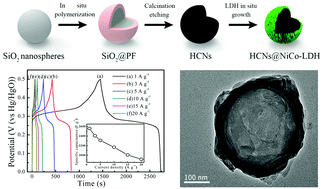Facile synthesis of core–shell nanostructured hollow carbon nanospheres@nickel cobalt double hydroxides as high-performance electrode materials for supercapacitors
Abstract
Core–shell nanostructured hollow carbon nanospheres@nickel cobalt double hydroxides (HCNs@NiCo-LDH) were fabricated using a facile hydrothermal method and investigated as high-performance electrode materials for supercapacitors. HCNs were acquired by a successive polymerization, carbonization and etching process, which was subsequently wrapped by ultrathin NiCo-LDH nanosheets. The HCNs@NiCo-LDH electrode achieved a high specific capacitance (2558 F g−1 at 1 A g−1) and outstanding rate capability with 74.9% capacitance retention after a 20-fold increase in current density. Capacitances of 2405, 2310, 2168, 2006 and 1916 F g−1 can be achieved at rates of 3, 5, 10, 15 and 20 A g−1, respectively, which are much higher than the specific capacitances of most reported carbon loaded NiCo-LDH. Specifically, the assembled HCNs@NiCo-LDH//graphene asymmetric supercapacitor displayed distinguished capacitive behaviors with a prominent specific capacitance of 172.8 F g−1 and eminent cycling stability with 93.5% capacitance retention after 3000 cycles. These remarkable electrochemical properties indicate that the unique HCNs@NiCo-LDH core–shell electrode is highly promising for application in energy storage fields.



 Please wait while we load your content...
Please wait while we load your content...